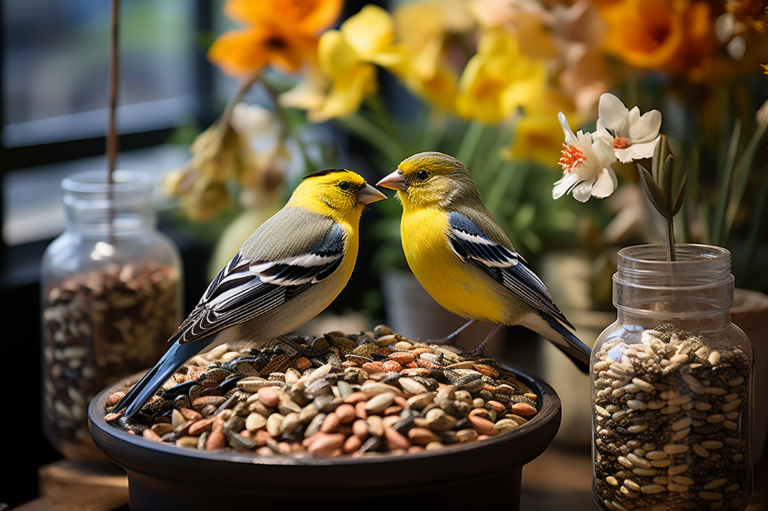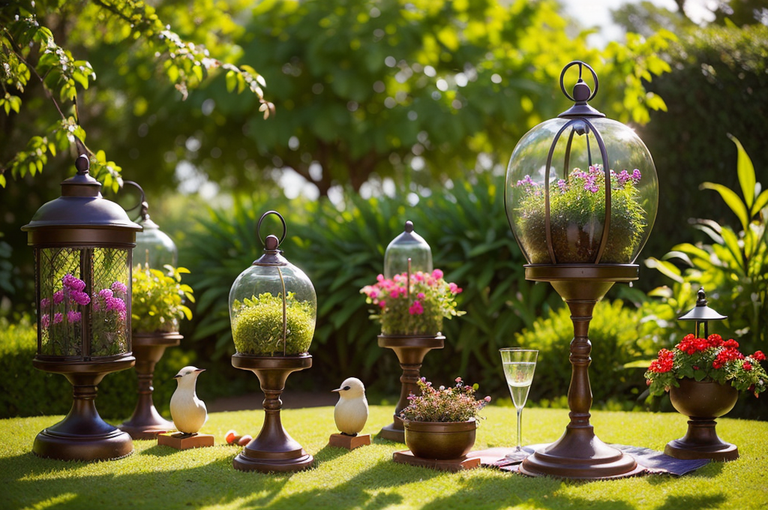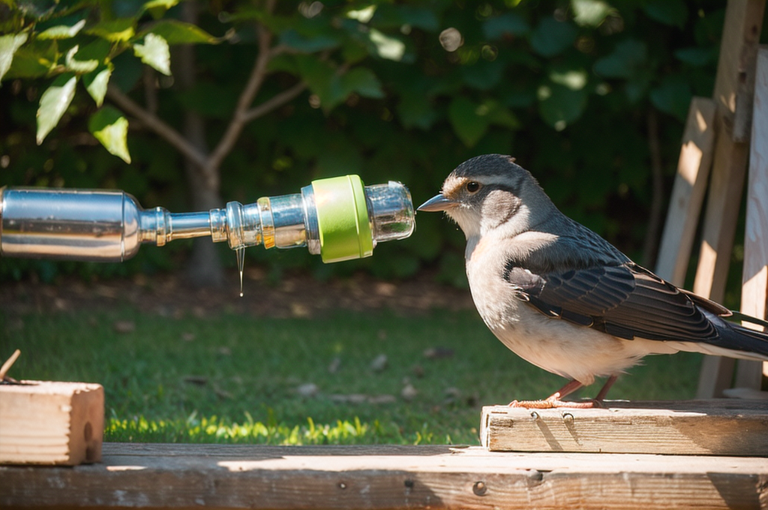Optimal Bird Feeding Guide: Attracting Feathered Friends with Fruits and Other Bird-friendly Foods

The article discusses ideal bird feed including fruits, unsalted peanuts, suet, sunflower seeds, and fresh water. It highlights avoiding harmful foods and the importance of feeder and nest location.
Importance of Fruits in Bird Feed
Feeding our fine feathered friends more than just the best birdseed for wild birds is a practice I deeply advocate. Diversifying their diet with fruits, much like ours, contributes to their overall health and vitality.
Types of Fruits Beneficial for Birds
There is a bountiful variety of fruits that are both nutritious and tantalizing to our avian companions. Apples, with their juicy crunch, are a delightful treat for birds, along with succulent berries, tart cherries, and a myriad of dried fruit variants. These offerings not only provide essential nutrients but also introduce new textures and flavors, creating a multisensory feast for our winged acquaintances.
Preparing Fruits for Feeding
Proper preparation of fruits is essential to ensure a safe and enjoyable feeding experience for birds. Fruits should be chopped into manageable pieces for easy intake. Remember, our friends on the branches have much smaller beaks than our bites! For dried fruits, a thorough night long soak will restore their luscious juiciness and make them more appealing to our avian guests.
Ways to Feed Fruits to Birds
The means of delivering these delicious delights can vary, from scattering fruit pieces directly on the ground to presenting them in a bird feeder. If you’re looking to get a bit more creative, try using mesh bags or suet cages. They can be an innovative solution to keep the larger, more aggressive birds from snatching whole fruits and provide the smaller and shyer species a fair chance at the feast. Each feeding method adds a unique dynamic to the thrilling theater of bird feeding, a spectacle that never ceases to amaze me.
Remember, while seeds may be a common choice, fruits are an equally crucial aspect of a bird’s diet. So, next time you’re planning your bird feed menu, consider some fruitful additions!

Using Proteins and Fats in Bird Feed
Ah, the melody that the birds produce in the early mornings! The divine composition is but a testament to the vitality bestowed upon them by the molecules of life, of proteins and fats, which I’ve included in their feed. You see, not only do I adore their serene symphony but also their overall wellbeing, granting them the best food for wild birds. 🎵🐦
Using peanuts and peanut butter
I unfailingly use unsalted, unroasted peanuts in my bird feed a gesture of care for my flitting friends. And who doesn’t love a smear of organic, salt free peanut butter? It’s such a splendid source of protein and birds seem to find it irresistible.
The role of suet and lard
There’s magic in the mundane, and so it is with suet and lard. Apart from serving as great binding agents in homemade bird food recipes, they offer an unexpected texture that birds find quite pleasing. Just remember, they should never be cooked a raw approach is best!
Incorporating seeds into feed
Ah, the humble seed, a repository of untold nourishment. Sunflower and Nyger seeds, in particular, are the jewels in my bird feed arsenal. They are incredibly nutritious, and the birds savour every morsel. It’s best to avoid ordinary seed mixes importance always lies in the details, you understand.
The allure of avian life is reflected in the contents of their feed, every particle a symbol of life’s mysteries and marvels. From seed to nut, it’s a labor of love, promoting health and enjoyment in every chirping chorus. After all, the song of a bird is a manifestation of its soul and the food, a testament to its thriving vitality.

Factors to Avoid in Bird Feeding
I’ve often seen well intended bird enthusiasts make errors when feeding their avian neighbors. Understanding what to avoid in bird feeding can enhance the lives of our winged friends and keep them frolicking freely in our skies. As someone who is wild about birds, let me share some essential precautions with you.
Harmful Foods for Birds
Our first instinct might be to share our meals with them, but foods like milk and stale/mouldy bread are damaging to bird health. Such fare is to birds what fast food is to humans: readily available, but detrimental in the long run.
Preventing Food Spoilage and Fermentation
Foods that can spoil or ferment pose another significant risk. It’s akin to leaving meat on a sun bathed countertop and then consuming it a recipe for disaster. Such food invites pests and must be used up within a couple of days.
The Risk of Using Kitchen Scraps and Frozen Fruits
Although you can use kitchen scraps like overripe fruit and seeds from pumpkins, ensure they are fresh and not soiled. Excess summer fruit can be frozen and given as a winter treat. However, it’s essential to remember that your kitchen waste is not a substitute for the nutrient rich food and insects they’d find in their natural habitat.
Taking precautions and ensuring we don’t inadvertently harm our feathered friends is the first significant increment towards being responsible bird enthusiasts. Bird feeding is an art and a science intertwined into a harmonious symphony that everyone can learn and appreciate. Just as a conductor must understand the nuances of each instrument, we must understand the needs of every bird we aim to nourish.

Enhancing Bird Attraction
Attracting a variety of birds to your backyard holds a unique appeal, notably, it begins with the basics; offering the best bird food for wild birds and a regular source of fresh water. Especially in the winter, the unfrozen water can be a lifeline for our feathered friends.💧
Providing Fresh Water for Birds
Ice free water is not just a need for us humans but for birds too. A clean birdbath, water tray, or a small pond can be an irresistible attraction for birds. This simple act can not only enrich your backyard ecosystem, but it can also carve a special place for you in avian communities, as a provider, a friend, and an observer.
Location of Bird Feeders and Nests
Smack in the middle of a bustling human activity, or hidden away in fearful seclusion? Neither! Positioning bird feeders and nests requires a balance a place safe from predators but within sight for you to enjoy the daily flurry of feathered activity. It’s a mutual pact wherein we respect the vulnerability of feathered visitors while they in turn give us that precious slice of their existence. 👁️
Economical Options for Bird Feeding
While gourmet birdseed has its place, the best bird food for wild birds can sometimes be found in the humble offerings of your kitchen leftover rice, apple cores, breadcrumbs, pumpkin seeds. The list is endless. For those abundant summer and fall fruits freeze them. A winter treat while you potentially help birds survive the harsh season, a win win!
After all, featuring as a small but critical character in the grand narrative of wild birds, doesn’t always require an extravagant script, just the right intention backed by insightful actions. 🐦
Offering Dried Fruits and Vegetables
Delving into the territory of avian nourishment, several varieties of dried fruits and vegetables weave themselves into the fabric of an ideal diet for our wild friends. These humble earth born morsels are not merely suitable, they are the very essence of wild about birds, the best birdseed for wild birds.
Suitability of Dried Fruits and Vegetables
What might mere dried cranberries and raisins hold in store for those tiny beaks, you wonder? Nutritional riches, my friend! Packed with fibers, vitamins, and minerals, these desiccated gems offer an additional punch of nutrition, making them the best bird food for wild birds.
Preparation of Dried Fruits and Vegetables
In the enchanting gloaming of twilight, I find myself submerging bountiful raisins and dried fruits in clear, sparkling water. Just as dawn begins to paint the sky, these fruits have soaked up enough moisture, their vivacious flavors more accessible to our feathered heartthrobs.
Serving Dried Fruits and Vegetables
The dance of the morning sun awakens more than just my senses; it marks the serving of these hydrated jewels to our flying confidantes. Assemble them artfully on the feeding platform, let them mingle with other feed items, or extend your hand, luring a curious visitor to sample the feast. Whatever your style, these treats serve as the encapsulation of all things wild about birds.
Garnering a deeper understanding of their nutritive needs and desires, our relationships with the wilderness indeed deepen. To be a part of this serene cadence, in my own small way, is an honor. Remember dear reader, gay or gray, every day is a perfect day to feed the birds. They truly appreciate our contribution… as do I.


